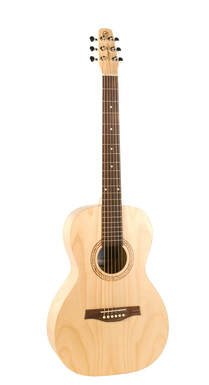 Hello, GITC Reader! I am Sophia Beltz, a 13 year old aspiring singer/songwriter from Pennsylvania. Music has been my passion for as long as I can remember. I hope that one day I can make a name for myself and share my passion with others. In today’s world, it is very common that people of my age are not given a chance for their voice to be heard. However, on January 23, 2019, I was given the opportunity to speak out on something I am very passionate about - women in the music industry. An organization known as GAMA, Guitars and Accessories Marketing Association, approached me back at the Nashville NAMM show in the summer of 2018. They wanted me and two other women to speak out on women in the music industry and how manufacturers can tend to treat us. GAMA is a group of professionals in the music products industry who make or distribute guitars, ukuleles and related musical accessories. They gather to create and support ways of making these instruments better understood and more widely available.  It was such an amazing experience to present for a room full of adults who were really ready listen to what I had to say. A common theme when companies are trying to appeal to women is adding sparkles and pink to anything and everything they can. Even though, yes, there are plenty of women who love sparkles, pink, and flowers, that doesn’t apply to every woman. Every woman is different and deserves to have a guitar that she loves and that makes her feel comfortable - whether that be sparkly pink, or a simple spruce top dreadnought. I hope my messages about equality and diversity were received, and that they are taken into consideration on how to be more inclusive in the work environment. I wish that not only women, but all people of different races, ethnicities, and lifestyles have a chance to have their voices heard in the industry. In the following days, I was approached by many people at the NAMM show who had been there for the panel. Not only did I get to discuss women in music further, but I also had a chance to learn about so many different businesses and products. One of them being an amazing organization known as GITC, Guitars in the Classroom. I was approached by the founder and executive director, Jessica Baron. I was lucky enough to be invited to the breakfast they held for the sponsors. I’ll never forget sitting in a circle of 60 strangers and being able to connect and play songs together.  (L to R) Martin Guitar's Sandy Seigfried, Mari Groller, Sophia Beltz, Sharon Beltz (Mom) and Skip Beltz (dad). (L to R) Martin Guitar's Sandy Seigfried, Mari Groller, Sophia Beltz, Sharon Beltz (Mom) and Skip Beltz (dad). The 2019 NAMM show was such a delightful experience that I would gladly do over. I learned so much about the behind the scenes in business and how to talk/present myself better when talking to different people. Not only were the people amazing, but the instruments were too! The variety of styles and models of guitars and ukuleles still get me excited thinking about them. From Martin and Godin guitars to Mahalo ukuleles. I love how a company can take an instrument and make it so much of their own.  There is nothing I would ever want to change about the experience I had the week of the 2019 NAMM show. I am so excited to see what comes with all of the knowledge and connections I have gained. The people and the environment were all so positive. I hope with everything in me that it continues to be that way, so that when my generation does take on the world and continues to spread the joy of music, we can always count on NAMM to be a positive stepping stone in our journey. You can follow Sophia's musical journey on facebook HERE.
2 Comments
 By Jennifer Hughes March 5, 2019 Acoustic guitars, no matter the size and shape, are affected by humidity and temperature. Whether it’s an inexpensive starter guitar, a mid-range acoustic guitar below $1500 or a high-end professional model, it can get damaged when subjected to low or high humidity and extreme changes in temperature. How Humidity and Temperature Affect Acoustic Guitars Humidity refers to the amount of water vapor or moisture in the air. A low humidity means the air is drier, while a high humidity means there’s a lot of moisture in the air. Relative humidity is the amount of moisture in your surroundings relative to the amount of moisture the air can hold before the saturation point is reached. As the temperature increases, so does the air’s ability to hold additional water.  Changes in relative humidity, along with changes in temperature, cause damage to an acoustic guitar. The wood on acoustic guitars reacts to humidity in the same way that other types of wood do. It swells when it’s too moist and it shrinks when it’s too dry. When a guitar is exposed to dry conditions for a long period of time, it loses its stored moisture and the wood shrinks. This may result in cracking, the frets protruding and the action getting low with lots of fret buzz. A too-dry acoustic guitar that has shrunk puts a lot of strain on the top, compromising the structural integrity, play-ability and sound of a guitar. If a guitar is exposed to excessive humidity, the seams may separate, the action may become unplayable and the bridge may come loose. These kinds of damage are why it’s important to make sure you store your guitar in a place with ideal levels of humidity.  How to Keep Your Acoustic Guitar in Good Playing Condition The ideal humidity range for all acoustic guitars is 45 to 55 percent. Here are some tips to follow to make sure you protect your guitar from the ravages of extreme humidity and temperature changes:
Final tip: If you are unsure of the extent of the humidity and temperature damage to your guitar and what you need to do to fix it, don’t hesitate to bring it to a guitar technician right away. There’s no quick fix or restoration process for acoustic guitars, so it’s best to leave the repairs to the pros. |
BlogArchives
June 2024
Categories
All
|
Copyright © 2024 Guitars In The Classroom. All rights reserved.

 RSS Feed
RSS Feed